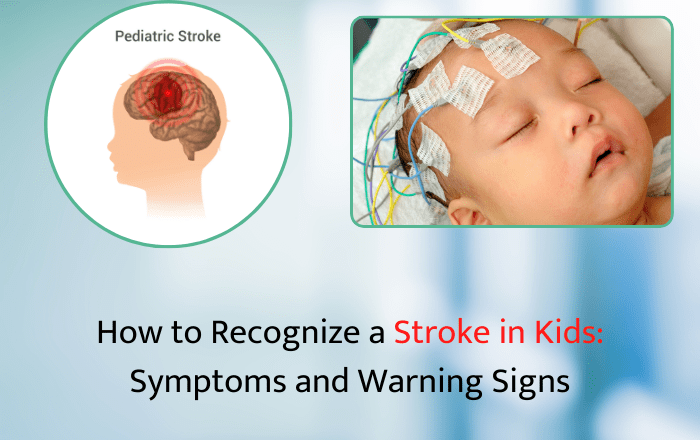Strokes are often associated with older adults, but they can happen to children too. Though rare, strokes in children are serious and require immediate attention. Recognizing the symptoms early can make a big difference in your child’s recovery and overall health.
In this blog, we’ll explore how to identify a stroke in kids, the unique signs to watch for, and what steps to take if you suspect your child is having a stroke. Understanding this condition can help you act quickly in an emergency.
1. What is a Stroke? Understanding Pediatric Strokes
A stroke occurs when the blood supply to the brain is disrupted, either due to a blockage (ischemic stroke) or bleeding in the brain (hemorrhagic stroke). This interruption prevents oxygen from reaching brain cells, which can lead to damage.
In children, strokes can occur due to:
- Congenital heart defects.
- Blood disorders like sickle cell disease.
- Infections such as meningitis.
- Head trauma or injury.
- Abnormal blood vessels in the brain.
While strokes in children are less common than in adults, the underlying causes and symptoms often differ, making it essential for parents to know what to look for.
2. Key Symptoms of Stroke in Children
The signs of a stroke in children can vary based on age. Here are some key symptoms to watch for:
Infants and Toddlers:
- Seizures, often focused on one part of the body.
- Extreme fussiness or crying without an apparent reason.
- Trouble feeding or using one side of the body.
Young adults:
- Sudden weakness or paralysis on one side of the body.
- Difficulty speaking or slurred speech.
- Trouble understanding others.
- Vision problems, such as blurred vision or loss of sight in one eye.
- Headaches or dizziness, sometimes with vomiting.
If you notice any of these symptoms, don’t wait to see if they go away. Immediate action is critical.
3. Recognizing Stroke Warning Signs: FAST for Kids
FAST is a simple acronym to help identify stroke symptoms, but it’s usually tailored for adults. Here’s how to adapt it for kids:
Face: Is one side of the child’s face drooping? Can they smile evenly?
Arms: Can the child lift both arms? Does one drift downward?
Speech: Is their speech slurred or hard to understand?
Time: If you notice any of these signs, call emergency services immediately.
In children, seizures or behavioral changes can sometimes be the only clue, so it’s important to stay alert.
4. What to Do If You Suspect a Stroke in Your Child
If you think your child may be having a stroke, follow these steps:
- Call Emergency Services: Time is critical. Inform the dispatcher that you suspect a stroke.
- Stay Calm: Your child needs you to stay composed and offer reassurance.
- Keep Your Child Safe: Ensure they’re lying down in a comfortable position. Avoid giving food or drink.
- Note the Time: Medical teams need to know when symptoms began to determine the best course of action.
Acting quickly can improve outcomes, so trust your instincts and don’t delay.
5. Pediatric Stroke Treatment Options and Recovery
Once at the hospital, doctors will perform tests like MRI scans, CT scans, or blood tests to confirm the stroke and its cause. Treatment options may include:
- Medications to dissolve clots in ischemic strokes.
- Surgery to stop bleeding in hemorrhagic strokes.
- Therapies to manage any underlying conditions contributing to the stroke.
After the acute phase, children often require rehabilitation, including:
- Speech therapy: To address communication difficulties.
- Physical therapy: To strengthen muscles and improve mobility.
- Occupational therapy: To relearn daily activities.
Every child’s recovery is different, but with proper care, many can regain essential skills and live healthy lives.
6. Prevention of Strokes in Kids
While not all strokes are preventable, you can reduce the risk by:
- Ensuring regular medical checkups.
- Managing conditions like sickle cell disease or heart problems.
- Encouraging a healthy lifestyle, including a balanced diet and regular physical activity.
- Staying alert to any unusual symptoms or health concerns in your child.
- Early detection and proactive care can go a long way in reducing the likelihood of strokes.
When to See a Specialist: Dr. Harshal Agrawal
If your child has experienced a stroke or you’re concerned about risk factors, consulting a pediatric neurologist is essential. Dr. Harshal Agrawal in Thane is highly regarded for his expertise in child brain stroke treatment and other neurological conditions affecting children.
With extensive experience in pediatric neurology, Dr. Agrawal offers specialized child brain stroke treatment in Thane, guiding you through diagnosis, treatment, and recovery. Whether your child needs a consultation or ongoing care, seeking advice from a qualified professional is a crucial step toward their well-being.
FAQs about Strokes in Children
Q1. Can children really have strokes?
Yes, while rare, strokes do occur in children. Early recognition and treatment are crucial for recovery.
Q2. What age group is most at risk for pediatric strokes?
Strokes can happen at any age, including infancy, but the risk is higher in children with specific health conditions.
Q3. Are strokes hereditary in children?
Some conditions that increase stroke risk, such as clotting disorders, can have a genetic component.
Understanding the symptoms and warning signs of pediatric strokes can help you act quickly in a critical moment. Don’t hesitate to seek medical help if you suspect your child may be experiencing a stroke.
If you’re in Thane, consider consulting Dr. Harshal Agrawal for guidance and care. Together, we can raise awareness about pediatric strokes and ensure children get the help they need.

